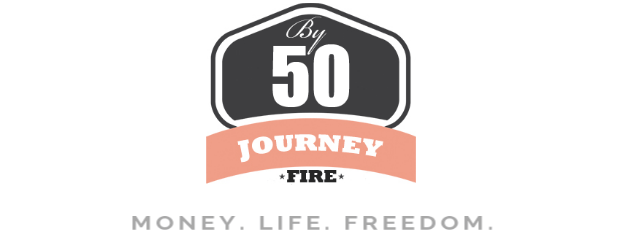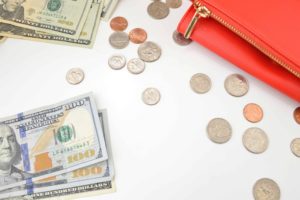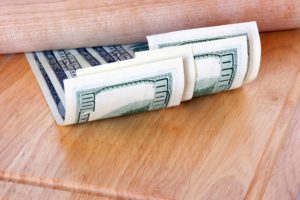How To Pay Off Debt Fast With No Money
Regardless of whether or not you’re trying to specifically clean up your credit for a future purchase, or trying to gain financial security, it feels amazingly great to have a mountain of debt lifted off of your shoulders. Today, I’m going to share my 5 simple steps to pay off debt fast with no money.
Having some debt is a given in American society – such as a mortgage or a car loan. It is almost a way of life for the U.S. middle-class families. Certainly, you can pay cash for those things. Especially, when it comes to buying a car. We all know that a car will go down in value but we still finance it and are willing to pay for the interest.
STEP 1: Figure out everything you owe
Firstly in this step is to know where you stand. You don’t want to just pay bills as they arrive in your mailbox, without knowing exactly how much you owe total, as well as a broken down amount.
Secondly, gather all of your debt and your monthly expenses information. What you want is to organize them. You can do it with a pen and paper or use a spreadsheet like Excel or Google Doc.

Next, list all of your debt including credit cards, student loans, car loans, medical bills, and money you owe to family or friends, etc. Don’t let yourself guess at these numbers. Look at your current statement or better yet, call customer service for a current balance in case you’ve charged more since the last statement mailed out. I utilize a free online tool called Personal Capital and this has made my financial organization life so much easier. It shows all of our accounts in one place without the need to log in into multiple accounts online.
Debt:
- Credit cards
- Store cards
- Student loan
- Car loan
- Personal Loan
- Home Equity Line of Credit (HELOC)
- Medical bills
- Family/Friends
- Other debts
Now, gather all of your current monthly expenses that are not based on revolving credit. This includes things like:
- Rent/Mortgage
- Monthly utility bills; Electric, Gas, Water, Phone, Internet, TV, Trash pick-up & recycling, etc.
- Groceries
- Transportation; Fuel, Toll, Parking fee, etc.
- Personal expenses; haircut, clothing, entertainment, etc.
- Daycare and Childcare
- Tuition
- Others
Here you want to know several things about your debt:
- The current total amount of balance due
- The available credit
- The minimum payment due
- The interest rate you’re being charged
And here you want to know several things about your monthly expenses:
- Monthly average spent on each utility
- Due dates on rent/mortgage and utility bills
After figuring out everything you owe and writing them down, you can now see where you stand financially. Most importantly, make it a point to stop spending on your credit card that day. You don’t want to dig your hole deeper. Now, pay cash for things from this point on. This is temporary. I realize there’s the benefit of using credit cards (to get points, cashback, travel hack, and so on). However, your focus now is paying off debt as fast as you can so stop digging the hole until you’re above the ground.
This helps you see exactly where your money has to go each month. It might shock you to see it all laid out in front of you – especially if you’re used to juggling bills and living paycheck to paycheck.
STEP 2: Decide how you want to pay things off
There are 2 approaches to how you should pay off debt. Both are widely accepted by financial experts.
The first method is called “A Snowball” method. Snowball means you start small and end up on a roll, making a bigger ball. As a result, you are pay off debt faster just like a snowball rolling faster as you pick up more snow at the end. You do this by listing your debt in order from the smallest amount owed to the largest amount owed regardless of the interest rates. Then, you make minimum payments on other debts but the first one. Meanwhile, you throw all the money you have left for the first debt. Hence, you’ll pay off the first debt which is the smallest amount you owed quickly.
This gives you a sense of accomplishment. You’ll feel great after paying the first one off quickly and want to keep going. The idea here is that you’ll find it very motivating to see a credit debt wiped out. Furthermore, it frees up a minimum payment that you then apply to the next smallest credit card on your list.
The second method is called “A Debt Avalanche” method. This means you pay off the debt with the highest interest rate first, which saves you money in the long run due to you’re no longer paying that high rate. This is mathematically sound advice. Personally, I used this method to pay off our debt of nearly $100K in under 6 years. Also, it happened that our largest debt had the highest interest rate. It took us almost 3 years just to pay off the first one. But after our first debt paid off, the list of our debts went rather quickly.
Both methods are good.
If you want to cheer yourself on and celebrate each milestone, then a Snowball method might work better for you. If math is of utmost importance, then you might want a Debt Avalanche method because you can celebrate the money you’re saving in interest. Please don’t spend too much time deciding which method you’re going to choose. Just pick a plan and then work it. The most important things are that you should decide which method better suits you and to stick to the plan.
STEP 3: Create a family budget and stick to it
Without a family budget, you won’t make much progress in how you pay off your debt – no matter which debt payoff method you choose. You know how dieting is all about calories in – calories out?
Well money is no different. You want to spend less than you earn. Just as you listed your debt so that you could see it all spelled out for you, you have to do the same with your family money.
Write down what you earn and what your partner earns. Pool all sources, including child support or alimony if you’re divorced. Add up the incoming monies and compare it to the debt that you have in regards to minimum payments.
You want to tally up everything – school fees or activities, birthday gifts, Christmas, and fun things you do as a family. You might need to go back through past statements to see what you’ve spent on discretionary items.
You’re going to want to start building up a bit of buffer or an emergency fund. You don’t want to make arrangements to spend every last dollar – when something unexpected might pop up that you have to address.

If you realize that you have too many bills all piling up at one time of the month, you can contact your lenders and ask for a new new due date or billing cycle. This can be easily done through a single click on settings/option on your credit card account online. Log in into your account to see if there’s an option to do so. Changing a new due date or billing cycle can help if you and your partner get paid twice monthly or weekly rather than one monthly paycheck.
As you start to get debt paid off, it’s important that you update your monthly budget to adjust for things you’ve paid off or paid down or when you have more money coming in.
I’ve written a detailed post on how to create a budget that works. Check out how to create an amazing budget plan for your family.
STEP 4: Figure out how you can earn more and spend less
First let’s talk about cutting down on your expenses. When you’re serious about debt reduction, you have to feel the belt tightening or else you’re not doing everything you can to get out of debt fast enough! Make sure you check out what 45 things we do to save money.

Here’re some things you can do to cut costs and save more money that you can put toward debt:
1. Get rid of unnecessary expenditures
For example, do you really need the newspaper? Can you go online and read the news or watch it on TV instead? How about bottled water you buy every now and then – is it a luxury you can do without temporarily?
Do you have a landline and a cell phone bill? Would it be possible to get rid of your landline phone service and just go with a cell phone for the time being? If so, that’s one less payment each month.
2. Cut back on existing packages
Cable TV is a budget buster. You might spend hundreds of dollars getting tons of movie channels and special packages for sports and entertainment. Cut back to a basic plan. Or cut the cable off totally. If you need to, there’re much cheaper alternatives – Netflix, Apple TV, Ruku, Amazon Prime, streaming TV, for much less than you would pay for a cable TV package.
If you can bundle things to save money, do it. For example, you might have your phone, cable TV and internet service all with different companies. Or you might have your car insurance and home insurance with different companies. You can save money by bundling them with one provider or one company.
3. Save on electricity and water
Make sure you and everyone in your family understands the importance of turning off lights and conserving electricity for your monthly bills. You can replace your regular light bulbs with LED light bulbs. The cost of replace them will break even quickly (from 100-watt light bulbs to 5-watt light bulbs, for example). Same with water usage – don’t let the water run while brushing your teeth, replace shower heads with low flow shower heads and install faucet aerators, don’t do small loads of dishes and laundry, the list goes on and on… Head to what 45 things we do to save money to see what little crazy things we do to save money every month.
4. Quit eating out
Eating out at restaurants doesn’t help you stick to a budget. It might help you save time stopping by for fast food but it can wreak havoc on your pocketbook and monthly budget.
5. See who is charging you more
If you have credit cards that are charging you annual fees without significant benefits, you should switch to credit cards that offer no annual fee. You should also want to check things like your bank accounts to see if they’re charging you a monthly fee for using their service. There are some banks that will do away with this charge to keep you as a customer.
6. Make a meal plan
People who shop without a list tend to spend more than people who make a weekly meal plan and budget for their families. Shop based on whatever coupons your local store is offering in the weekly paper can save a significant amount of money annually.
Make sure you pack lunches instead of eating out at work. As Dave Ramsey says, you can live on beans and rice while you’re paying off your debt if you’re serious about it.
7. Look for cheaper forms of entertainment
Don’t have an official date night out every weekend where you’re shelling out for an expensive dinner and a movie. Instead (when the pandemic has ended, of course), invite other couples over and have game night at your house with snacks and wine. Enjoy a movie night at home as a family instead of spending money on movie tickets, popcorn and drinks. Go to a nearby park, walk on a trail and have a picnic there. The list goes on and on. There’re many things you could do and entertain yourself and your family without spending a lot. Entertainment doesn’t need to be expensive.
Once you have seen how you can spend less, look at how you can earn more. Whether you get a side hustle, host garage sale, open an Etsy shop, or make money working from home online. You can pull that extra money toward your debt.
8. Sell your clutter
This is a good opportunity to tidy your home and earn extra money. You’ll be surprised at how much you can make from selling your unused items. If you don’t use them, why keep them. Anything in your home that sits for more than a year without being used needs to go. It’s such a good way to declutter your home and put the extra money toward your debt. You can sell them on facebook marketplace or online communities like ThredUp, Poshmark, Cash4Books, Decluttr, Etsy, Usell, etc.
STEP 5: Keep at it and Stay debt-free!
The most important thing to remember is that once you start digging your way our of debt, you can’t fall back into the old trap a second time (or third or fourth!). Some people find spending is a hard habit to break.
When you pay off your debt, you might find it hard to see all of that available credit and try to resists the urge to charge your cards up again. But a better way would be to save up the cash and spend it that way. Even better if you save up the cash for all of your purchases but then use a credit card to pay for it off every month (this way you can take advantages of credit card perks like travel miles, points, and cash back). Of course, if you can’t save up enough cash or don’t have enough to pay off your credit cards every month, stick to cash purchase only.

Using cash for purchases can often save you money, not just in the absence of interest charges, but because retailers will sometimes give you a discount when you pay cash.
Save up an emergency fund that covers at least 3 months’ worth of your necessary expenses. That way, you’re covered in case you have an issue that lasts longer than a few days off work, or an emergency pops up that you weren’t prepared for.
Summary
There are many reasons some people don’t try to get rid of their consumer debt. They may think that it is impossible. The timeline and subsequent payoff are too long for the mind to perceive. I know, it’s frustrating thinking about your debt. Patience is key here. Don’t think about how long it takes to pay off your debt. As long as your debt balance is less than a month before, you’re doing great.
However, for most people, they just spend way too much money or living beyond their means. It’s that simple. Or they just don’t want to be debt free bad enough. We all know how to save money and how to spend less. The actions are harder than words. Most of us don’t really need any more advice on how to save or how to spend less, either. We know how this is done, we just gotta do it.
The only difference that truly matters in the question of being debt free is “Determination”. You can do this – you got it.

What are things that prevent you to pay off your debt?
What steps do you want to take today?
Leave me a comment below, I actually respond to these : )








